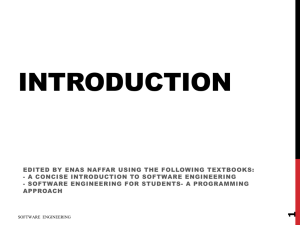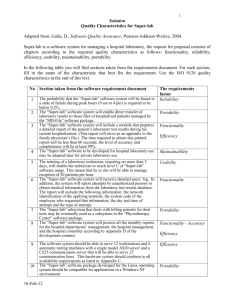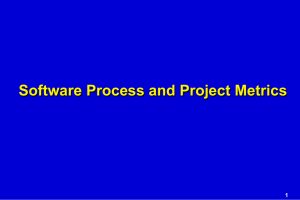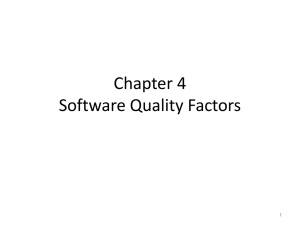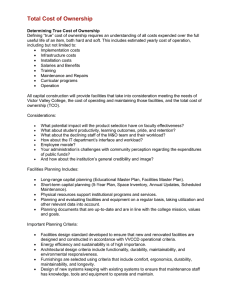Introduction SOFTWARE ENGINEERING 1
advertisement
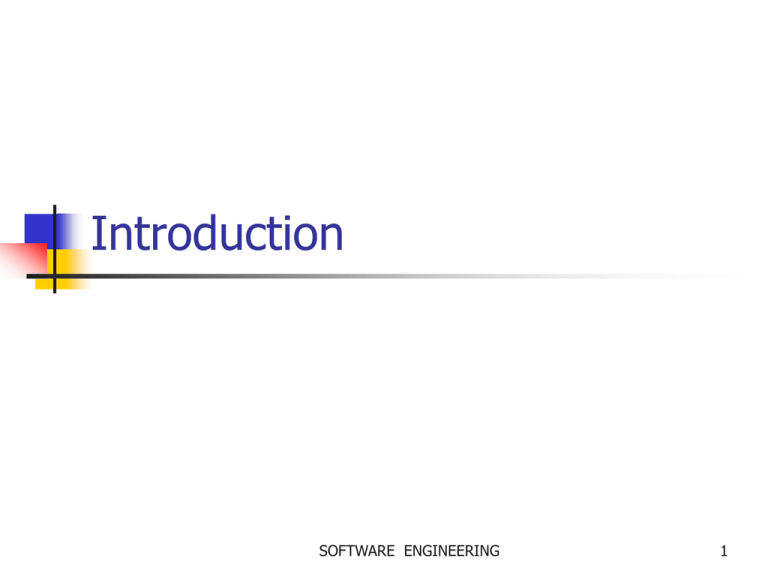
Introduction SOFTWARE ENGINEERING 1 Software Software (IEEE): collection of programs, procedures, rules, and associated documentation and data SOFTWARE ENGINEERING 2 Software Q : If you have to write a 10,000 line program in C to solve a problem, how long will it take? Answers: generally range from 2-4 months Let us analyze the productivity Productivity = output/input resources In SW output is considered as LOC Input resources is effort - person months; overhead cost modeled in rate for person month Though not perfect, some productivity measure is needed, as project has to keep it high SOFTWARE ENGINEERING 3 Software … The productivity is 2.5-5 KLOC/PM Q: What is the productivity in a typical commercial SW organization ? A: Between 100 to 1000 LOC/PM Q: Why is it low, when your productivity is so high? (people like you work in the industry) A: What the student is building and what the industry builds are two different things SOFTWARE ENGINEERING 4 Software… In a univ. a student system is built while the commercial org builds industrial strength sw What is the difference between a student program and industrial strength sw for the same problem? SOFTWARE ENGINEERING 5 Software… Student Developer is the user bugs are tolerable UI not important No documentation Industrial Strength Others are the users bugs not tolerated UI v. imp. issue Documents needed for the user as well as for the organization and the project SOFTWARE ENGINEERING 6 Software… Student SW not in critical use Reliability, robustness not important No investment Don’t care about portability Industrial Strength Supports important functions / business Reliability , robustness are very important Heavy investment Portability is a key issue here SOFTWARE ENGINEERING 7 Industrial strength software Student programs for a problem & industrial strength software are two different things Key difference is in quality (including usability, reliability, portability, etc.) Brooks thumb-rule: Industrial strength sw costs 10 time more than student sw In this course, software means industrial strength software This software has some characteristics SOFTWARE ENGINEERING 8 Is Expensive Let us look at costs involved Productivity = Appx 1000 LOC/PM Cost = $3K to $10K/PM Cost per LOC = $5 to $15 I.e, each line of delivered code costs many $s A simple application for a business may have 20KLOC to 50KLOC Cost = $100K to $2.25Million Can easily run on $10K-$20K hardware So HW costs in an IT solution are small as compared to SW costs. SOFTWARE ENGINEERING 9 Requires tight Schedule Business requirements today demand short delivery times for software In the past, software products have often failed to be completed in time Along with cost, cycle time is a fundamental driving force SOFTWARE ENGINEERING 10 Productivity – for cost and schedule An industrial strength software project is driven by cost and schedule Both can be modeled by productivity, measured in terms of output per unit effort (e.g. LOC per person month) Higher productivity leads to lower cost Higher productivity leads to lower cycle time Hence, for projects (to deliver software), quality and productivity are basic drivers SOFTWARE ENGINEERING 11 Quality Along with productivity, quality is the other major driving factor Developing high Q sw is a basic goal Quality of sw is harder to define SOFTWARE ENGINEERING 12 Quality – ISO standard SOFTWARE ENGINEERING 13 Quality – ISO std… ISO std has six attributes Functionality Reliability Usability Efficiency Maintainability Portability SOFTWARE ENGINEERING 14 Quality – ISO standard Functionality. The capability to provide functions which meet stated and implied needs when the software is used. Reliability. The capability to provide failurefree service. Usability. The capability to be understood, learned, and used. Efficiency. The capability to provide appropriate performance relative to the amount of resources used. 15 Quality – ISO standard Maintainability. The capability to be modified for purposes of making corrections, improvements, or adaptation. Portability. The capability to be adapted for different specified environments without applying actions or means other than those provided for this purpose in the product. SOFTWARE ENGINEERING 16 Quality… Multiple dimensions mean that not easy to reduce Q to a single number Concept of Q is project specific For some reliability is most important For others usability may be more important Reliability is generally considered the main Q criterion SOFTWARE ENGINEERING 17 Quality… Reliability = Probability of failure To normalize Quality = Defect density hard to measure approximated by no. of defects in software Quality = No. of defects delivered / Size Defects delivered - approximated with no. of defects found in operation Current practices: less than 1 def/KLOC What is a defect? Project specific! SOFTWARE ENGINEERING 18 Quality – Maintainability Once SW delivered, it enters the maintenance phase, in which: Corrective maintenance: correct discovered problems. Adaptive maintenance: Modification of a software to keep a software product usable in a changed or changing environment. Perfective maintenance: Modification of a software to improve performance or maintainability. Preventive maintenance: Modification of a software to detect and correct latent faults in the software product before they become effective faults. 19 Quality – Maintainability Maintenance can consume more effort than development over the life of the software (can even be 20:80 ratio!) Hence maintainability is another quality attribute of great interest SOFTWARE ENGINEERING 20 Quality and Productivity Hence, quality and productivity (Q&P) are the basic drivers in a sw project The aim of most methodologies is to deliver software with a high Q&P Besides the need to achieve high Q&P there are some other needs SOFTWARE ENGINEERING 21 scale and change there are some other characteristics of the problem domain that also influence the solution approaches employed. We focus on two such characteristics : scale and, change SOFTWARE ENGINEERING 22 Change Only constant in business is change! Requirements change, even while the project is in progress In a project, up to 40% of development effort may go in implementing changes Practices used for developing software must accommodate change SOFTWARE ENGINEERING 23 Scale Most industrial strength software tend to be large and complex Methods for solving small problems do not often scale up for large problems Two clear dimensions in a project engineering project management For small, both can be done informally, for large both have to be formalized to make sure that cost, schedule, and quality are under control 24 Scale: Examples Gcc 980KLOC C, C++, yacc Perl 320 KLOC C, perl, sh Appache 100 KLOC C, sh Linux 30,000 KLOC C, c++ Windows XP 40,000 KLOC C, C++ SOFTWARE ENGINEERING 25 Scale… SOFTWARE ENGINEERING 26 Scale… An illustration of issue of scale is counting the number of people in a room vs taking a census Both are counting problems Methods used in first not useful for census For large scale counting problem, must use different techniques and models Management will become critical SOFTWARE ENGINEERING 27 Scale… As industry strength software tends to be large, hence methods used for building these must be able to scale up For much of the discussion, we will high Q&P as the basic objective SOFTWARE ENGINEERING 28 Summary The problem domain for SE is industrial strength software SE aims to provide methods for systematically developing (industrial strength) software Besides developing software the goal is to achieve high quality and productivity (Q&P) Methods used must accommodate changes, and must be able to handle large problems SOFTWARE ENGINEERING 29
